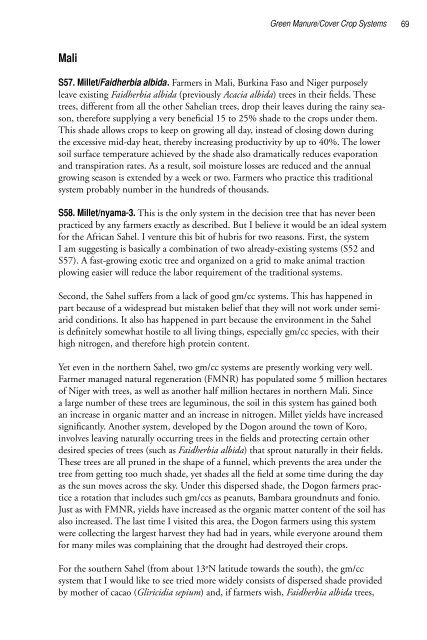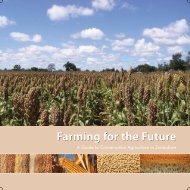Restoring the Soil - Canadian Foodgrains Bank
Restoring the Soil - Canadian Foodgrains Bank
Restoring the Soil - Canadian Foodgrains Bank
Create successful ePaper yourself
Turn your PDF publications into a flip-book with our unique Google optimized e-Paper software.
Green Manure/Cover Crop Systems69MaliS57. Millet/Faidherbia albida. Farmers in Mali, Burkina Faso and Niger purposelyleave existing Faidherbia albida (previously Acacia albida) trees in <strong>the</strong>ir fields. Thesetrees, different from all <strong>the</strong> o<strong>the</strong>r Sahelian trees, drop <strong>the</strong>ir leaves during <strong>the</strong> rainy season,<strong>the</strong>refore supplying a very beneficial 15 to 25% shade to <strong>the</strong> crops under <strong>the</strong>m.This shade allows crops to keep on growing all day, instead of closing down during<strong>the</strong> excessive mid-day heat, <strong>the</strong>reby increasing productivity by up to 40%. The lowersoil surface temperature achieved by <strong>the</strong> shade also dramatically reduces evaporationand transpiration rates. As a result, soil moisture losses are reduced and <strong>the</strong> annualgrowing season is extended by a week or two. Farmers who practice this traditionalsystem probably number in <strong>the</strong> hundreds of thousands.S58. Millet/nyama-3. This is <strong>the</strong> only system in <strong>the</strong> decision tree that has never beenpracticed by any farmers exactly as described. But I believe it would be an ideal systemfor <strong>the</strong> African Sahel. I venture this bit of hubris for two reasons. First, <strong>the</strong> systemI am suggesting is basically a combination of two already-existing systems (S52 andS57). A fast-growing exotic tree and organized on a grid to make animal tractionplowing easier will reduce <strong>the</strong> labor requirement of <strong>the</strong> traditional systems.Second, <strong>the</strong> Sahel suffers from a lack of good gm/cc systems. This has happened inpart because of a widespread but mistaken belief that <strong>the</strong>y will not work under semiaridconditions. It also has happened in part because <strong>the</strong> environment in <strong>the</strong> Sahelis definitely somewhat hostile to all living things, especially gm/cc species, with <strong>the</strong>irhigh nitrogen, and <strong>the</strong>refore high protein content.Yet even in <strong>the</strong> nor<strong>the</strong>rn Sahel, two gm/cc systems are presently working very well.Farmer managed natural regeneration (FMNR) has populated some 5 million hectaresof Niger with trees, as well as ano<strong>the</strong>r half million hectares in nor<strong>the</strong>rn Mali. Sincea large number of <strong>the</strong>se trees are leguminous, <strong>the</strong> soil in this system has gained bothan increase in organic matter and an increase in nitrogen. Millet yields have increasedsignificantly. Ano<strong>the</strong>r system, developed by <strong>the</strong> Dogon around <strong>the</strong> town of Koro,involves leaving naturally occurring trees in <strong>the</strong> fields and protecting certain o<strong>the</strong>rdesired species of trees (such as Faidherbia albida) that sprout naturally in <strong>the</strong>ir fields.These trees are all pruned in <strong>the</strong> shape of a funnel, which prevents <strong>the</strong> area under <strong>the</strong>tree from getting too much shade, yet shades all <strong>the</strong> field at some time during <strong>the</strong> dayas <strong>the</strong> sun moves across <strong>the</strong> sky. Under this dispersed shade, <strong>the</strong> Dogon farmers practicea rotation that includes such gm/ccs as peanuts, Bambara groundnuts and fonio.Just as with FMNR, yields have increased as <strong>the</strong> organic matter content of <strong>the</strong> soil hasalso increased. The last time I visited this area, <strong>the</strong> Dogon farmers using this systemwere collecting <strong>the</strong> largest harvest <strong>the</strong>y had had in years, while everyone around <strong>the</strong>mfor many miles was complaining that <strong>the</strong> drought had destroyed <strong>the</strong>ir crops.For <strong>the</strong> sou<strong>the</strong>rn Sahel (from about 13 o N latitude towards <strong>the</strong> south), <strong>the</strong> gm/ccsystem that I would like to see tried more widely consists of dispersed shade providedby mo<strong>the</strong>r of cacao (Gliricidia sepium) and, if farmers wish, Faidherbia albida trees,
















